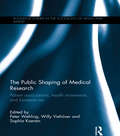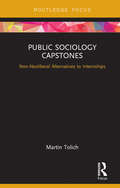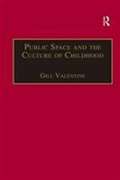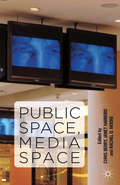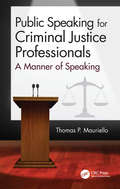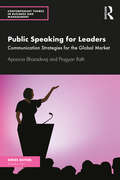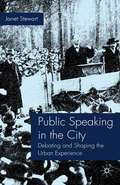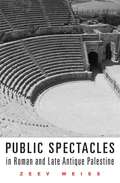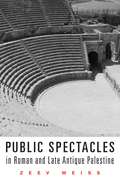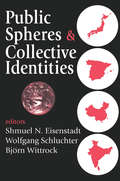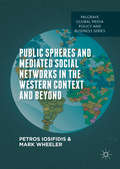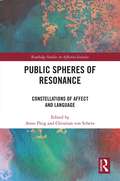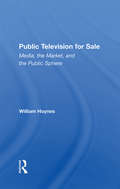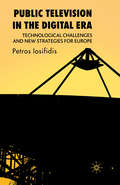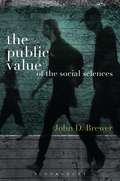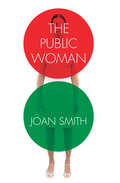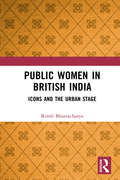- Table View
- List View
The Public Shaping of Medical Research: Patient Associations, Health Movements and Biomedicine
by Peter Wehling Willy Viehöver Sophia KoenenPatient organizations and social health movements offer one of the most important and illuminating examples of civil society engagement and participation in scientific research and research politics. Influencing the research agenda, and initiating, funding and accelerating the development of diagnostic tools, effective therapies and appropriate health-care for their area of interest, they may champion alternative, sometimes controversial, programs or critique dominant medical paradigms. Some movements and organizations advocate for medical recognition of contested illnesses, as with fibromyalgia orADHD, while some attempt to "de-medicalize" others, such as obesity or autism.Bringing together an international selection of leading scholars and representatives from patients' organizations, this comprehensive collection explores the interaction between civil society groups and biomedical science, technology development, and research politics. It takes stock of the key findings of the research conducted in the field over the past two decades and addresses emerging problems and future challenges concerning the interrelations between health movements and patient organisations on the one hand, and biomedical research and research policies on the other hand. Combining empirical case studies with conceptual discussion, the book discusses how public participation can contribute to, as well as restrict, the democratization of scientific knowledge production.This volume is an important reference for academics and researchers with an interest in the sociology of health and illness, science and technology studies, the sociology of knowledge, medical ethics or healthcare management and research, as well as medical researchers and those involved with health-related civil society organizations.
Public Sociology Capstones: Non-Neoliberal Alternatives to Internships
by Martin TolichSocial science departments, both nationally and internationally, market boundless career destinations for their graduates but fail to identify the pathways to these lucrative destinations, and appear oblivious to the social forces that threaten their existence, such as the discerning parent’s investment in their offspring’s education and mounting individual student debt. This book responds to these social forces, drawing on Michael Burawoy’s model of Public Sociology to show how a research-centred experiential internship provides opportunities for students to draw on their prior learning and realise their potential to create pathways towards employment. The author demonstrates how a specific, research-based course leading to employment with a non-government organisation or government department was evaluated and incrementally developed, giving voice to its multiple beneficiaries. Designed for university teachers, this book will appeal to those in social science departments who are using an internship, service learning or capstone model for their senior undergraduate classes.
Public Sociology Capstones: Non-Neoliberal Alternatives to Internships
by Martin TolichSocial science departments, both nationally and internationally, market boundless career destinations for their graduates but fail to identify the pathways to these lucrative destinations, and appear oblivious to the social forces that threaten their existence, such as the discerning parent’s investment in their offspring’s education and mounting individual student debt. This book responds to these social forces, drawing on Michael Burawoy’s model of Public Sociology to show how a research-centred experiential internship provides opportunities for students to draw on their prior learning and realise their potential to create pathways towards employment. The author demonstrates how a specific, research-based course leading to employment with a non-government organisation or government department was evaluated and incrementally developed, giving voice to its multiple beneficiaries. Designed for university teachers, this book will appeal to those in social science departments who are using an internship, service learning or capstone model for their senior undergraduate classes.
Public Space And The Culture Of Childhood
by Gill ValentineChildren are at the heart of popular and public debates in North America and Europe about the culture of public space. On the one hand there is increased anxiety about children's vulnerability to stranger danger, on the other there is a rising tide of fear about out of control and dangerous youth. This book addresses both these debates about children's role in public space, setting them within an academic framework and drawing on a range of interdisciplinary work on childhood, young people and parenting. It is therefore relevant to practitioners and policy makers concerned with the nature and future of public space, and to academics researching or teaching about childhood, family or public space in the disciplines of sociology, social policy and geography
Public Space And The Culture Of Childhood (PDF)
by Gill ValentineChildren are at the heart of popular and public debates in North America and Europe about the culture of public space. On the one hand there is increased anxiety about children's vulnerability to stranger danger, on the other there is a rising tide of fear about out of control and dangerous youth. This book addresses both these debates about children's role in public space, setting them within an academic framework and drawing on a range of interdisciplinary work on childhood, young people and parenting. It is therefore relevant to practitioners and policy makers concerned with the nature and future of public space, and to academics researching or teaching about childhood, family or public space in the disciplines of sociology, social policy and geography
Public Space, Media Space
by Chris Berry, Janet Harbord and Rachel MoorePublic Space, Media Space asks how media saturation are transforming public space and our experience of it. From the role of graffiti and Youtube videos of street art in the Cairo revolution, to OOH (Out of Home) advertising, the book is diverse in its approach and global in its coverage.
Public Speaking for Criminal Justice Professionals: A Manner of Speaking
by Thomas P MaurielloPublic Speaking for Criminal Justice Professionals: A Manner of Speaking is a one-of-a-kind public speaking guide specifically written for criminal justice professionals, written by a criminal justice professional. Author Thomas Mauriello has worked his entire professional career both as a practitioner and as an educator in the fields of criminal justice and forensic science. This book outlines the public speaking skills he has learned, used, and taught to thousands of criminal justice, forensic science, security, and counterintelligence professionals over the years. The book can either be read from cover-to-cover—to fine tune the reader’s existing oral communication skills—or read in a modular fashion, as a reference guide to focus on certain skills and techniques. A list of over 55 proven, effective presentation tools will be listed, discussed, and demonstrated throughout the book—using illustrated criminal justice and forensic sciences topic examples. Contrary to popular believe, simply knowing your subject or being an expert in the subject does not guarantee a successful presentation. Aristotle, who many recognize as the Father of Public Speaking and Forensic Debate, said it best when he declared, "It is not enough to know what to say, one must know how to say it." This guide focuses on technique and the recognition that a speaker must have of both the subject and the listener. The purpose is to improve readers' skill level and ability to engage and, thereby, inform the listener. Whether preparing to speak to one person, or one thousand people, Public Speaking for Criminal Justice Professionals provides specific techniques for professionals to speaking with confidence, and present effective engaging presentations.
Public Speaking for Criminal Justice Professionals: A Manner of Speaking
by Thomas P MaurielloPublic Speaking for Criminal Justice Professionals: A Manner of Speaking is a one-of-a-kind public speaking guide specifically written for criminal justice professionals, written by a criminal justice professional. Author Thomas Mauriello has worked his entire professional career both as a practitioner and as an educator in the fields of criminal justice and forensic science. This book outlines the public speaking skills he has learned, used, and taught to thousands of criminal justice, forensic science, security, and counterintelligence professionals over the years. The book can either be read from cover-to-cover—to fine tune the reader’s existing oral communication skills—or read in a modular fashion, as a reference guide to focus on certain skills and techniques. A list of over 55 proven, effective presentation tools will be listed, discussed, and demonstrated throughout the book—using illustrated criminal justice and forensic sciences topic examples. Contrary to popular believe, simply knowing your subject or being an expert in the subject does not guarantee a successful presentation. Aristotle, who many recognize as the Father of Public Speaking and Forensic Debate, said it best when he declared, "It is not enough to know what to say, one must know how to say it." This guide focuses on technique and the recognition that a speaker must have of both the subject and the listener. The purpose is to improve readers' skill level and ability to engage and, thereby, inform the listener. Whether preparing to speak to one person, or one thousand people, Public Speaking for Criminal Justice Professionals provides specific techniques for professionals to speaking with confidence, and present effective engaging presentations.
Public Speaking for Leaders: Communication Strategies for the Global Market (Contemporary Themes in Business and Management)
by Apoorva Bharadwaj Pragyan RathThis book studies the art of public speaking as oration instead of just ornamentation. It repositions public speaking as a fundamental business leadership act and a solution-enabling and problem-solving communication approach. Drawing on in-depth case studies, it considers various situations that a managerial leader encounters and delivers speech solutions as strategic manoeuvres for attaining desired targets. The volume: Deals with public speaking exclusively from a business perspective; Produces a workable manual of managerial public speaking that introduces the concept of oration as Or-action (oratory that leads to desired action); Presents a variegated analysis of speech texts from history, politics, fiction, social media, film industry, platform content, and business-product presentations; Customizes speeches into unique speech clusters where readers can readily find the type of speech texts they require for their own specific content development. The first of its kind, this book will be a key text for entrepreneurs, corporate managers, academic practitioners, and executives. It will also be of interest to students and researchers of behavioural economics, rhetoric, strategy, communication studies, business communication, fiction theory, generation studies, and virtual reality studies.
Public Speaking for Leaders: Communication Strategies for the Global Market (Contemporary Themes in Business and Management)
by Apoorva Bharadwaj Pragyan RathThis book studies the art of public speaking as oration instead of just ornamentation. It repositions public speaking as a fundamental business leadership act and a solution-enabling and problem-solving communication approach. Drawing on in-depth case studies, it considers various situations that a managerial leader encounters and delivers speech solutions as strategic manoeuvres for attaining desired targets. The volume: Deals with public speaking exclusively from a business perspective; Produces a workable manual of managerial public speaking that introduces the concept of oration as Or-action (oratory that leads to desired action); Presents a variegated analysis of speech texts from history, politics, fiction, social media, film industry, platform content, and business-product presentations; Customizes speeches into unique speech clusters where readers can readily find the type of speech texts they require for their own specific content development. The first of its kind, this book will be a key text for entrepreneurs, corporate managers, academic practitioners, and executives. It will also be of interest to students and researchers of behavioural economics, rhetoric, strategy, communication studies, business communication, fiction theory, generation studies, and virtual reality studies.
Public Speaking in the City: Debating and Shaping the Urban Experience
by J. StewartProviding a compelling analysis of debates in and about the modern city, this book draws upon architecture, history, literary studies, new media and sociology to explore the multiple connections between location, speech and the emerging modern metropolis. It concludes by reflecting on public speaking in the construction of the virtual city.
Public Spectacles in Roman and Late Antique Palestine (Revealing Antiquity Ser. #21)
by Zeev WeissWishing to ingratiate himself with Rome, Herod the Great built theaters, amphitheaters, and hippodromes to bring pagan entertainments of all sorts to Palestine. Zeev Weiss explores how the indigenous Jewish and Christian populations responded, as both spectators and performers, to these cultural imports, which left a lasting imprint on the region.
Public Spectacles in Roman and Late Antique Palestine (Revealing Antiquity Ser. #21)
by Zeev WeissWishing to ingratiate himself with Rome, Herod the Great built theaters, amphitheaters, and hippodromes to bring pagan entertainments of all sorts to Palestine. Zeev Weiss explores how the indigenous Jewish and Christian populations responded, as both spectators and performers, to these cultural imports, which left a lasting imprint on the region.
Public Spheres and Collective Identities
by Walter LippmannToday it is assumed that we understand contemporary nationalism and nation-building. Researchers rarely consider the very different traditions from which such state-building emerged. Instead, there is almost too much discussion of the "global village," with its supposed uniformity and inevitable trajectories. We need to view modernity as something other than a single condition with a preordained future. New visions of a modern civilization are emerging throughout the world, calliing for a far-reaching appraisal of the older visions of modernization.Following Eisenstadt's and Schluchter's introduction, Bjorn Wittrock explores the varieties and transitions of early modern societies, noting that only by looking at societies' collective identities and their modes of mediating in the public sphere can the distinguishing factors between modernity be appreciated. Sheldon Pollock discusses the use of vernacular language in India through its literary culture and polity, 1000-1500. Sanjay Subrahmanyam, sums up major developments in the recent historiography of South Asia from 1400 to 1750. David L. Howell focuses on the boundaries of the early modern Japanese state, including its political boundaries and the boundaries of collective identity and social status. Mary Elizabeth Berry examines public life in authoritarian Japan. Frederic Wakeman, Jr. probes the boundaries of the political game and how they were affected by the increased political centralization that developed after the disorder of the Ming-Qing transition during the seventeenth century. Alexander Woodside discusses territorial order and collective-identity tensions in Confucian Asia. Bernhard Giesen argues that the French Enlightenment can be described as an extension of absolutist court culture. Finally essay, Victor Perez-Diaz examines the state and public sphere in Spain during the Ancient Regime contrasting two ideal types of states--a "nomocratic" model and a "teleocratic" model.This volume addresses cultural and political practices not only from outside the European and American spheres but also over long periods of time in which the internal dynamics of other civilizations become visible. Its broad-ranging use of empirical materials enables us to think comparatively and historically about the ways in which different modernities took shape.
Public Spheres and Collective Identities
by Walter LippmannToday it is assumed that we understand contemporary nationalism and nation-building. Researchers rarely consider the very different traditions from which such state-building emerged. Instead, there is almost too much discussion of the "global village," with its supposed uniformity and inevitable trajectories. We need to view modernity as something other than a single condition with a preordained future. New visions of a modern civilization are emerging throughout the world, calliing for a far-reaching appraisal of the older visions of modernization.Following Eisenstadt's and Schluchter's introduction, Bjorn Wittrock explores the varieties and transitions of early modern societies, noting that only by looking at societies' collective identities and their modes of mediating in the public sphere can the distinguishing factors between modernity be appreciated. Sheldon Pollock discusses the use of vernacular language in India through its literary culture and polity, 1000-1500. Sanjay Subrahmanyam, sums up major developments in the recent historiography of South Asia from 1400 to 1750. David L. Howell focuses on the boundaries of the early modern Japanese state, including its political boundaries and the boundaries of collective identity and social status. Mary Elizabeth Berry examines public life in authoritarian Japan. Frederic Wakeman, Jr. probes the boundaries of the political game and how they were affected by the increased political centralization that developed after the disorder of the Ming-Qing transition during the seventeenth century. Alexander Woodside discusses territorial order and collective-identity tensions in Confucian Asia. Bernhard Giesen argues that the French Enlightenment can be described as an extension of absolutist court culture. Finally essay, Victor Perez-Diaz examines the state and public sphere in Spain during the Ancient Regime contrasting two ideal types of states--a "nomocratic" model and a "teleocratic" model.This volume addresses cultural and political practices not only from outside the European and American spheres but also over long periods of time in which the internal dynamics of other civilizations become visible. Its broad-ranging use of empirical materials enables us to think comparatively and historically about the ways in which different modernities took shape.
Public Spheres and Mediated Social Networks in the Western Context and Beyond (Palgrave Global Media Policy and Business)
by Mark Wheeler Petros IosifidisSocial media is said to radically change the way in which public communication takes place: information diffuses faster and can reach a large number of people, but what makes the process so novel is that online networks can empower people to compete with traditional broadcasters or public figures. This book critically interrogates the contemporary relevance of social networks as a set of economic, cultural and political enterprises and as a public sphere in which a variety of political and socio-cultural demands can be met. It examines policy, regulatory and socio-cultural issues arising from the transformation of communication to a multi-layered sphere of online and social networks. The central theme of the book is to address the following questions: Are online and social networks an unstoppable democratizing and mobilizing force? Is there a need for policy and intervention to ensure the development of comprehensive and inclusive social networking frameworks? Social media are viewed both as a tool that allows citizens to influence policymaking, and as an object of new policies and regulations, such as data retention, privacy and copyright laws, around which citizens are mobilizing.
Public Spheres of Resonance: Constellations of Affect and Language (Routledge Studies in Affective Societies)
by Anne Fleig Christian Von ScheveTo understand the profound changes in the modes of public political debate over the past decade, this volume develops a new conception of public spheres as spaces of resonance emerging from the power of language to affect and to ascribe and instill collective emotion. Political discourse is no longer confined to traditional media, but increasingly takes place in fragmented and digital public spheres. At the same time, the modes of political engagement have changed: discourse is said to increasingly rely on strategies of emotionalization and to be deeply affective at its core. This book meticulously shows how public spheres are rooted in the emotional, bodily, and affective dimensions of language, and how language – in its capacity to affect and to be affected – produces those dynamics of affective resonance that characterize contemporary forms of political debate. It brings together scholars from the humanities and social sciences and focuses on two fields of inquiry: publics, politics, and media in Part I, and language and artistic inquiry in Part II. The thirteen chapters provide a balanced composition of theoretical and methodological considerations, focusing on highly illustrative case studies and on different artistic practices. The volume is an indispensable source for researchers and postgraduate students in cultural studies, literary studies, sociology, and political science. It likewise appeals to practitioners seeking to develop an in-depth understanding of affect in contemporary political debate.
Public Spheres of Resonance: Constellations of Affect and Language (Routledge Studies in Affective Societies)
by Anne Fleig Christian Von ScheveTo understand the profound changes in the modes of public political debate over the past decade, this volume develops a new conception of public spheres as spaces of resonance emerging from the power of language to affect and to ascribe and instill collective emotion. Political discourse is no longer confined to traditional media, but increasingly takes place in fragmented and digital public spheres. At the same time, the modes of political engagement have changed: discourse is said to increasingly rely on strategies of emotionalization and to be deeply affective at its core. This book meticulously shows how public spheres are rooted in the emotional, bodily, and affective dimensions of language, and how language – in its capacity to affect and to be affected – produces those dynamics of affective resonance that characterize contemporary forms of political debate. It brings together scholars from the humanities and social sciences and focuses on two fields of inquiry: publics, politics, and media in Part I, and language and artistic inquiry in Part II. The thirteen chapters provide a balanced composition of theoretical and methodological considerations, focusing on highly illustrative case studies and on different artistic practices. The volume is an indispensable source for researchers and postgraduate students in cultural studies, literary studies, sociology, and political science. It likewise appeals to practitioners seeking to develop an in-depth understanding of affect in contemporary political debate.
Public Television For Sale: Media, The Market, And The Public Sphere
by William HoynesPublic television is uniquely positioned in our country to contribute to the invigoration of democratic public life because, ostensibly, it is neither driven by the market nor dominated by the state. In this comprehensive analysis of the forces that shape our public television system, sociologist William Hoynes finds that public television increasi
Public Television For Sale: Media, The Market, And The Public Sphere
by William HoynesPublic television is uniquely positioned in our country to contribute to the invigoration of democratic public life because, ostensibly, it is neither driven by the market nor dominated by the state. In this comprehensive analysis of the forces that shape our public television system, sociologist William Hoynes finds that public television increasi
Public Television in the Digital Era: Technological Challenges and New Strategies for Europe
by P. IosifidisBy looking at a range of different European Public Television (PTV) broadcasters, this book investigates the challenges that these broadcasters encounter in a competitive digital broadcasting environment and reveals the different policies and strategies that they are adopting in order to remain accountable, competitive and efficient.
The Public Value of the Social Sciences: An Interpretive Essay
by John D. BrewerWhat is the purpose of social science? How can social science make itself relevant to the intractable problems facing humanity in the twenty-first century? The social sciences are under threat from two main sources. One is external, reflected in a global university crisis that imposes the marketization of higher education on the ancient practice of scholarship. The other, internal threat is social science's withdrawal from publicly–engaged teaching and research into the protective bunker of disciplinarity. In articulating a vision for the public role of social science in the twenty-first century, John Brewer argues that these threats also constitute an opportunity for a new public social science to emerge, confident in its public value and fully engaged with the future of humanity in its teaching, research and civic responsibilities, while also remaining committed to science. The argument is presented in the form of an interpretive essay: thought-provoking, forward-looking, and challenging to intellectual orthodoxy. It should be read and debated by all researchers and teachers in the social science disciplines who are concerned by the future of higher education and the relevance of their subjects to the future of humankind.
The Public Woman
by Joan SmithWomen have never had more freedom yet questions of inequality persist from the bedroom to the workplace. A quarter of a century after the publication of her seminal text Misogynies, Joan Smith looks at what women have achieved - and the price they've paid for it. From Amy Winehouse to Pussy Riot, from the veil to domestic violence, a war is being fought over women's bodies and minds. Smith shows how misogyny has assumed new and dangerous forms as we confront an economic, social and religious backlash. But that's only part of the story. The female eunuch has become the public woman, and she isn't going to go quietly. Written with wit and passion, this forensic analysis sets out what we're up against - and how to fight back. 'Brilliant … A compelling rap sheet of 21st century misogynies and a reprimand to anyone who declares the battle for gender equality is over' - Robin Ince 'Joan Smith dares to expose woman-hating in all its forms. She does not shy away from naming religion and cultural relativism as barriers to liberation, and names men and the system of patriarchy as the problem. Read this book, not least because it will open your eyes to how much needs to be done before we consign male supremacy to the museum of ancient reli.' - Julie Bindel
Public Women in British India: Icons and the Urban Stage
by Rimli BhattacharyaThis book foregrounds the subjectivity of ‘acting women’ amidst violent debates on femininity and education, livelihood and labour, sexuality and marriage. It looks at the emergence of the stage actress as an artist and an ideological construct at critical phases of performance practice in British India. The focus here is on Calcutta, considered the ‘second city of the Empire’ and a nodal point in global trade circuits. Each chapter offers new ways of conceptualising the actress as a professional, a colonial subject, simultaneously the other and the model of the ‘new woman’. An underlying motif is the playing out of the idea of spiritual salvation, redemption and modernity. Analysing the dynamics behind stagecraft and spectacle, the study highlights the politics of demarcation and exclusion of social roles. It presents rich archival work from diverse sources, many translated for the first time. This book makes a distinctive contribution in intertwining performance studies with literary history and art practices within a cross-cultural framework. Interdisciplinary and innovative, it will appeal to scholars and researchers in South Asian theatre and performance studies, history and gender studies.
Public Women in British India: Icons and the Urban Stage
by Rimli BhattacharyaThis book foregrounds the subjectivity of ‘acting women’ amidst violent debates on femininity and education, livelihood and labour, sexuality and marriage. It looks at the emergence of the stage actress as an artist and an ideological construct at critical phases of performance practice in British India. The focus here is on Calcutta, considered the ‘second city of the Empire’ and a nodal point in global trade circuits. Each chapter offers new ways of conceptualising the actress as a professional, a colonial subject, simultaneously the other and the model of the ‘new woman’. An underlying motif is the playing out of the idea of spiritual salvation, redemption and modernity. Analysing the dynamics behind stagecraft and spectacle, the study highlights the politics of demarcation and exclusion of social roles. It presents rich archival work from diverse sources, many translated for the first time. This book makes a distinctive contribution in intertwining performance studies with literary history and art practices within a cross-cultural framework. Interdisciplinary and innovative, it will appeal to scholars and researchers in South Asian theatre and performance studies, history and gender studies.
